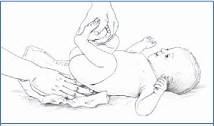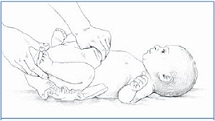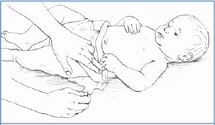Diaper-Changing Basics

Take off the old stuff and clean baby. (Keep baby’s front covered.)

Raise the baby’s bottom by pressing his ankles toward his chest. Slip a fresh diaper underneath baby by holding his ankles.

Make sure the diaper pattern is in front. Pull tabs and close side. Press tabs to seal.
Anyone who claims that giving a new baby a bath is “fun for you and baby” has either never had a baby or has forgotten how new babies hate being undressed and getting cold. Fortunately, babies don’t need much bathing. In fact, too much cleaning will deplete your baby’s natural skin oils and dry out his skin.
Ignore all notions that you must keep your baby immaculate. Babies really don’t need baths—they don’t sweat or crawl around, for example, so they just don’t get very dirty. Furthermore, temperature changes, such as those caused by the cooling of water as it evaporates off their wet skin, usually arouse screams of protest. It will be easier on both of you if you hold off bathing for as long as possible, even after the circumcision and umbilical cord sites have healed. In the meantime, damp mop your baby with a soft, warm washcloth while protecting him under a blanket or bath towel.
But if you must bathe, the best time for a bath is when your baby’s alert but not hungry.
Most parents find it easiest to use the kitchen sink for their baby’s first bathing experience (but you may have to wash that big pile of dirty dishes that’s accumulated since you got back home).
We suggest folding a thick bath towel and laying it in the bottom of the sink to support your baby and prevent him from slipping. Then add a few inches of warm water. Move the faucet out of the way to ensure you don’t accidentally knock the baby against it or turn on the water.
You’ll probably find that simply using your hands to soap and rinse your baby works better than trying to manage a washcloth.
If you want to, have a measuring cup of warm water or a small watering can with a pointed spout nearby to pour over your baby’s body to rinse him. Remember to monitor the water temperature, though, and also to move slowly: Babies are as slippery as eels when they’re wet.
Tip
Baby bathing is vastly overrated. Definitely postpone your baby’s first bath at least until the umbilical cord stump has fallen off, and the circumcision site has healed. After all, your baby hasn’t been outdoors rolling in the mud or rubbing his food or his poop all over himself. That comes later.
Another practical bathing option is to take your baby into the tub with you. Sit yourself down in waistdeep mildly warm water in the bathtub, and have your partner hand your baby to you. Then you can bring your knees up to support the baby. Remember that babies hate being quickly lowered down backward. It sets off a primitive reflex that makes them throw their arms up, gasp for air, and start screaming. They also react to sudden changes in temperature—especially when undressed and naked. The advantage to this “whole body” style of baby bathing is that your body feels warm and comforting to your baby and you can nurse him if he gets upset.
If you decide to get a molded baby bathtub, the best models have a non-slip, semi-reclined seating area, a plug in the base for easy draining, and thick sides for carrying the tub when it’s filled with water. (Only a few inches of water will be enough to do the job.)
Tip
If you haven’t installed a bath mat or slip-resistant stick-ons on the bottom of your bathtub, now’s the time to do it. Also, while you’re at it, turn down the temperature on your water heater’s thermostat to about 102° F to prevent scalding water from coming out the spigot. Your baby’s skin will burn from water that might feel comfortably hot to you.
Some travel tubs are lightweight and fold in two for easy storage. Large tubs often offer two different sides—one for reclining newborns, and the other for tots who are old enough to sit up. They can later be used for water play. (For more on baby bathtubs, see in 4. Gear Guide.)
Several bathing accessories can be helpful: Small, reclining baby hammocks and special baby-shaped sponges are inexpensive aids. The hammock-like baby recliners consist of a vinyl-coated frame and a seat made of terrycloth or a quick-drying fabric. Large bathing sponges cushion a baby’s back and bottom in a tub or sink.
How to give your baby a bath
New babies have primitive self-warming abilities. Warm up the room so he doesn’t feel chilly and start crying when you undress him. Gather together everything you’ll need so it’s within arm’s reach. On the list are clean pajamas or T-shirt; a fresh diaper; a gentle, nonper-fumed soap (get it wet ahead of time) or baby body wash; a soft baby hairbrush; a baby-style washcloth; a plastic measuring cup or watering can with a slender spout; and a big, soft towel. Lay a folded bath towel in the bottom of a baby’s bathtub or kitchen sink. Then fill the sink with 1 to 2 inches of lukewarm water.
Slowly lower the baby down so he’s on his back on a changing pad or towel, being sure to support his head and neck at all times. Take off his clothes and remove his diaper, setting it aside for throwaway.
After the bath, gently pat your baby dry while keeping him covered with the towel. Then put on his diaper and slip on his T-shirt or pajamas. Give him a minute to dry off before stepping out into the cold air, but don’t be tempted to blow-dry his hair: It will dry his tender skin, and may burn him.
Tip
Wash the crease behind your son’s scrotum, but don’t attempt to pull back the foreskin of his penis if he isn’t circumcised. It won’t be retractable for a few years. Girls naturally have a protective white substance called smegma in the folds of their vaginas. You can gently wipe down the area, but don’t try to get rid of it.
Baby soap and cosmetics
Other than special soap and shampoo, your baby doesn’t need a lot of “cosmetics”—powders, oils, lotions, and ointments that are marketed for baby cleanliness and skincare. They’re a waste of money, and some products, particularly those containing perfumes or strong chemicals, may irritate a baby’s tender skin.
Do buy baby-specific soap or an oatmeal-based or mild glycerin soap. Use a tearless baby shampoo for your baby’s scalp instead of soap that leaves a residue (see Your Baby’s First Shampoo in this chapter), but remember: There’s no such thing as “tearless.”
“My basic rule of thumb is if you can’t pronounce the name of the chemicals in a product for your baby’s skin or hair, and you can’t eat it, then it probably shouldn’t be put on the outside (or inside) of your baby, either.”
Baby powders containing talcum have been associated with a rare form of baby pneumonia. If the baby spills the powder onto his face and inhales the dust, the fine particles will irritate his lungs and may make the baby seriously ill.
If you do use powder, try a talcfree version, such as one made from kaolin clay powder, gently dusted onto your palms first before being applied to your baby’s diaper area. Keep your baby dry with your family’s regular terry towels laundered in a non-irritating, fragrance-free liquid detergent. Little baby towels with hoods are cute, but tend not to absorb well.
WARNING! Drowning Hazard
Babies can drown in less than an inch of water. Wet babies are very slippery. Be careful when lifting your baby from the sink or tub. NEVER leave your baby alone in a tub or suctioned bath seat to answer the front door or telephone, or to deal with a sibling or pet. Since 1983, more than 120 babies have drowned in suction-seat-related accidents, usually when the baby has been left alone or with a sibling for only a few minutes.